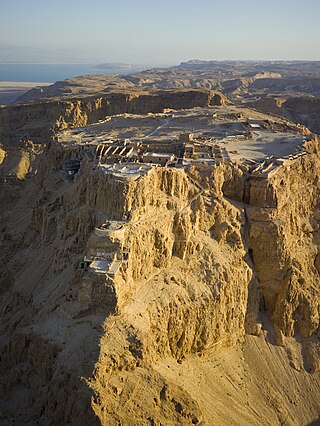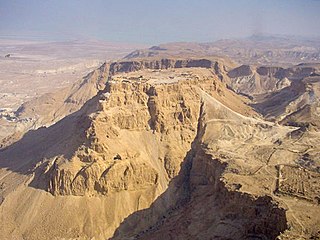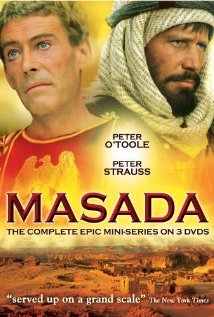Plot
Part I
In the year 70 AD, with the fall of Jerusalem and the destruction of the Second Temple, the Jewish rebellion against Roman occupation is declared over, but Eleazar ben Ya'ir and his family flee the city, vowing that the Judean War is not ended. Eleazar and his followers make their headquarters on top of the mountain fortress of Masada. From there they conduct raids on Roman occupied villages in the south of Judea. These guerrilla attacks threaten the credibility of the declared Roman victory. The commanding general of the 10th Legion, Cornelius Flavius Silva, arranges a meeting with Eleazar to negotiate a truce. Returning to Rome, Silva's hopes to implement a truce in Judea are quashed by the Emperor Vespasian, because of political pressures in the Roman Senate. Silva is sent back to Judea after securing the services of veteran Siege Commander Rubrius Gallus. Silva is also informed that his second in command, General Marcus Quadratus, and Head Tribune Merovius, are spies for the emperor's political enemy. While Silva is still in Rome, through the treachery of these two men, the truce is violently broken by the Romans.
Part II
Learning of the breaking of the truce upon his return from Rome, Silva marches the 5,000 men of the 10th Legion to the foot of Masada and lays a siege to the apparently impregnable fortress. He directs Quadratus and Merovius on a suicidal assault of the fortress in order to remove them from his forces and make them an example to any others who share their political leanings. Rubrius Gallus directs that a ramp be built to almost the summit of the mountain, intent on breaking through the Masada walls with the aid of a 50-foot (15.24 m) siege tower that is being constructed out of sight of the rebels. When Eleazar successfully attacks the Roman soldiers building the ramp with catapulted stones, Silva quickly rounds up hundreds of Jews from the surrounding area to use as slaves to continue the work, believing correctly that Eleazar will not attack fellow Jews. This makes Eleazar change his tactics to psychological warfare, allowing the heat of the sun and revealing the surplus of water on Masada to demoralize the Roman troops. Also, he acts to capitalize on the Romans' belief in reading the future from the entrails of sacrificed goats, leading a party through the Roman sentries at night to feed the goats maggots, knowing that their discovery during the rituals will be seen as a bad omen. Eleazar's problems are further compounded by his own religious doubts and opposition from the more pacifist groups on Masada.
Part III
The political opportunist Pomponius Falco arrives and under the authority of the Emperor Vespasian relieves Silva as legion commander. Intent on ending the siege quickly through the use of terror, Falco orders Jewish slaves to be killed one by one, by catapulting them into the side of the mountain, until Eleazar surrenders. Eleazar, a religious skeptic, runs to the Masada synagogue and calls to God to stop the killing. Revolted by Falco's barbaric actions, Silva forcibly takes back his command, stops the catapulting, and orders Falco placed under arrest. The cessation of Falco's terror is seen by the Zealots as a response to Eleazar's praying and affirmation of his leadership to them. Rubrius Gallus is killed by a Masadan arrow as he carries out measurements on the siege ramp, only living long enough to confirm his plans to his second in command.
Part IV
As the ramp nears completion, Eleazar faces the fact that the final confrontation with the Romans is not far off. The Zealots break into Herod's Armory and begin to prepare for what they believe will be a straightforward storming of the fortress walls by the Romans. When the ramp is complete, the Romans wheel out the armoured siege tower and battering-ram. Eleazar then realizes that he had underestimated Silva's strategy. As the tower begins moving up the ramp, Eleazar has his people build "an inner wall that will absorb the blows of the ram and not shatter." Made from wooden beams from Herod's Palace roof and packed with dirt, they finish it just as the tower reaches the top of the ramp. The Romans quickly break through the stone walls of the fortress, but the ram does nothing against the improvised inner wall. As the wall is made partly of wood, Silva orders his men to set fire to it. Deducing that it would take all night for the wall to burn through, Silva has his men stand down; the rest of the night is tense for both sides, as the fitful wind may as easily spread the blaze to the siege tower as burn down the inner wall. The next day, the Romans break into the fortress, only to discover that Eleazar and his people had all committed suicide during the night.
The closing line is said by a dispirited and despondent Silva, who mourns all that has been hoped and planned and lost by both sides whilst fighting for "a rock, in the middle of a wasteland, on the shore of a poisoned sea...".

Masada is an ancient fortification in southern Israel, situated on top of an isolated rock plateau, akin to a mesa. It is located on the eastern edge of the Judaean Desert, overlooking the Dead Sea 20 km (12 mi) east of Arad.

The 60s decade ran from January 1, AD 60, to December 31, AD 69.

The 70s was a decade that ran from January 1, AD 70, to December 31, AD 79.

AD 66 (LXVI) was a common year starting on Wednesday of the Julian calendar. At the time, it was known as the Year of the Consulship of Telesinus and Paullinus. The denomination AD 66 for this year has been used since the early medieval period, when the Anno Domini calendar era became the prevalent method in Europe for naming years.
AD 67 (LXVII) was a common year starting on Thursday of the Julian calendar. At the time it was known as the Year of the Consulship of Julius Rufus and Fonteius Capito. The denomination AD 67 for this year has been used since the early medieval period, when the Anno Domini calendar era became the prevalent method in Europe for naming years.

AD 73 (LXXIII) was a common year starting on Friday of the Julian calendar. At the time, it was known as the Year of the Consulship of Domitian and Messalinus. The denomination AD 73 for this year has been used since the early medieval period, when the Anno Domini calendar era became the prevalent method in Europe for naming years.
The Sicarii were a splinter group of the Jewish Zealots who, in the decades preceding Jerusalem's destruction in 70 CE, strongly opposed the Roman occupation of Judea and attempted to expel them and their sympathizers from the area. The Sicarii carried sicae, or small daggers, concealed in their cloaks. At public gatherings, they pulled out these daggers to attack Romans and alleged Roman sympathizers alike, blending into the crowd after the deed to escape detection.
Gaius Cestius Gallus was a Roman senator and general who was active during the Principate. He was suffect consul for the second nundinium of the year 42 as the colleague of Gaius Caecina Largus. Gallus was the son of Gaius Cestius Gallus, ordinary consul in 35.

The First Jewish–Roman War, sometimes called the Great Jewish Revolt, or The Jewish War, was the first of three major rebellions by the Jews against the Roman Empire fought in Roman-controlled Judea, resulting in the destruction of Jewish towns, the displacement of its people and the appropriation of land for Roman military use, as well as the destruction of the Jewish Temple and polity.

The siege of Masada was one of the final events in the First Jewish–Roman War, occurring from 72 to 73 CE on and around a hilltop in present-day Israel.

The siege of Jerusalem of 70 CE was the decisive event of the First Jewish–Roman War, in which the Roman army led by future emperor Titus besieged Jerusalem, the center of Jewish rebel resistance in the Roman province of Judaea. Following a five-month siege, the Romans destroyed the city and the Second Jewish Temple.

Judaea was a Roman province from 6 to 132 CE, which incorporated the Levantine regions of Judea, Samaria and Idumea, extending over parts of the former regions of the Hasmonean and Herodian kingdoms of Judea. The name Judaea was derived from the Iron Age Kingdom of Judah.

Legio X Fretensis was a legion of the Imperial Roman army. It was founded by the young Gaius Octavius in 41/40 BC to fight during the period of civil war that started the dissolution of the Roman Republic. X Fretensis is then recorded to have existed at least until the 410s.

Lucius Flavius Silva Nonius Bassus was a late-1st-century Roman general, governor of the province of Iudaea and consul. Silva was the commander of the army, composed mainly of the Legio X Fretensis, in 72 AD which laid siege to the near-impregnable mountain fortress of Masada, occupied by a group of Jewish rebels dubbed the Sicarii by Flavius himself. The siege ended in 73 AD with Silva's forces breaching the defenses of the Masada plateau and the mass suicide of the Sicarii, who preferred death to defeat or capture. Silva's actions are documented by 1st-century Jewish-Roman historian Josephus, the remains of a 1st-century Roman victory arch identified in Jerusalem in 2005, and the extensive earthworks at the Masada site, a monument to the high-water mark of Roman siege warfare.
Eleazar ben Simon was a Zealot leader during the First Jewish-Roman War who fought against the armies of Cestius Gallus, Vespasian, and Titus Flavius. From the onset of the war in 66 CE until the destruction of the temple in 70 CE, he fought vehemently against the Roman garrisons in Judea and against his fellow Jewish political opponents in order to establish an independent Jewish state at Jerusalem. Although the Jewish defeat at Jerusalem cannot be entirely attributed to Eleazar ben Simon, his inability to establish unity with John of Gischala and Simon bar Giora resulted in a bitter civil war that weakened the Jewish resistance against Rome. Eleazar ben Simon and his Zealots' radical anti-Roman policies and eradication of the moderate temple aristocracy from Jerusalem in 67 CE also prevented any peaceful agreement with Rome to avoid the death and destruction which ensued in 70 CE.

Sextus Lucilius Bassus was the 2nd Roman legate appointed by Emperor Vespasian to Iudaea Province in 71.

Imagine This is a musical with music by Shuki Levy, lyrics by David Goldsmith and a book by Glenn Berenbeim. Set in the Warsaw Ghetto during World War II, it focuses on a family of actors trying to stage a play about the siege at ancient Masada to inspire hope and optimism within the Jewish community.

The siege of Yodfat was a 47-day siege by Roman forces of the Jewish town of Yodfat which took place in 67 CE, during the Great Revolt. Led by Roman General Vespasian and his son Titus, both future emperors, the siege ended with the sacking of the town, the deaths of most of its inhabitants and the enslavement of the rest. It was the second bloodiest battle of the revolt, surpassed only by the Siege of Jerusalem, and the longest except for Jerusalem and Masada. The siege was chronicled by Josephus, who had personally commanded the Jewish forces at Yodfat and was subsequently captured by the Romans.
Eleazar ben Hanania was a Jewish leader during the Great Revolt of Judea. Eleazar was the son of the High Priest Hanania ben Nedebai and hence a political figure of the 1st century Judaea Province. Eleazar was the governor of the temple at the outbreak of the rebellion in 66 CE and following the initial outbreak of the violence in Jerusalem convinced the priests of the Jewish Temple to stop service of sacrifice for the Emperor. The action, though largely symbolic, was one of the main milestones to bring a full-scale rebellion in Judea.
The Dovekeepers is a two-part television adaptation based on the book of the same name by Alice Hoffman from executive producers Roma Downey and Mark Burnett. It features the Siege of Masada by troops of the Roman Empire towards the end of the First Jewish–Roman War. The program premiered in the United States on March 31, 2015 on CBS.











